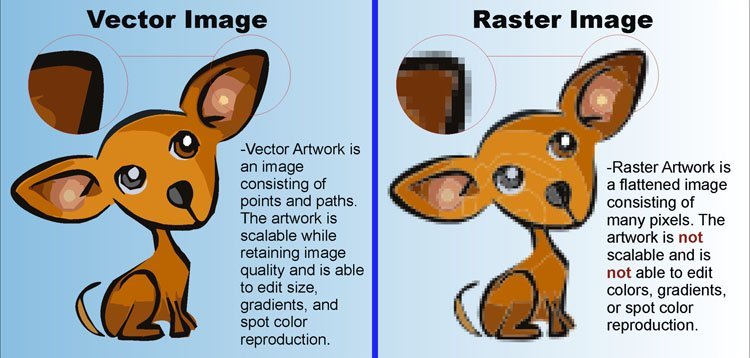What is Vector art?
In a vector file the computer remembers the shapes of the lines.
What is Raster art?
In raster, (sometimes called bitmap) the image is comprised of tiny dots that when viewed as a whole display the image

Photo Editors are Raster Based. A raster image is made of thousands of little dots, or pixels. Creating or editing an image with dots allows you to provide for rich detail in an image. Because every dot can be a different color, you can allow for any kind of color change. Raster images are wonderful for rendering rich, full-color images, like photographs. Raster-based programs do have some drawbacks, though:
* Raster images are file-heavy. All of the zeros and ones that are used to make up each pixel result in large files sizes. Your computer must keep track of the zeros and ones and must change each one when editing. This is memory-intensive and may cause slower editing.
* Rasters do not resize well. When you resize a raster image, the pixels just get larger, making the image appear distorted and chunky/grainy.
Photo editors, like Adobe PhotoShop, use raster-based images to allow for precise editing and total freedom in image appearance.
Illustration Programs are Vector Based
Vector-based programs approach image creation in an entirely different manner. A vector-based program does not render images on a pixel-by-pixel basis.
In a raster-based image creation program, a square would be made of thousands of pixel dots.
In a vector-based program, the same square would be made of only four dots, one on each corner. These “vector points,” basically allow your computer to play Connect the Dots. Each vector point has information in it telling your computer how to connect each point with straight or curved lines, and with what color to fill in the closed shape.
In the printed image, the vector points would be invisible.
Because the computer only has to keep four points in its memory, it is much easier for the computer to edit vector-based images.
If you resize a vector-based image, it loses little or no detail. The vector points spread out and the computer just redraws the image. You can easily color, or recolor, a vector-based image very easily using a drawing program. Vector images can also result in smoother lines because the lines are not hand drawn.
Vector images do have some drawbacks, however. They are generally filled with a solid color or a gradient but can’t display the lush color depth of a raster. They also work better with straight lines or sweeping curves.
Drawing programs, like Adobe Illustrator and Corel Draw, primarily use a vector-based drawing mode to allow for scalability and clean lines.
